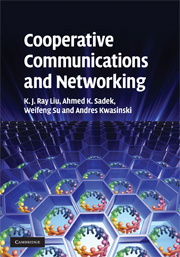Book contents
- Frontmatter
- Contents
- Preface
- Part I Background and MIMO systems
- Part II Cooperative communications
- 4 Relay channels and protocols
- 5 Cooperative communications with single relay
- 6 Multi-node cooperative communications
- 7 Distributed space–time and space–frequency coding
- 8 Relay selection: when to cooperate and with whom
- 9 Differential modulation for cooperative communications
- 10 Energy efficiency in cooperative sensor networks
- Part III Cooperative networking
- References
- Index
9 - Differential modulation for cooperative communications
from Part II - Cooperative communications
Published online by Cambridge University Press: 06 July 2010
- Frontmatter
- Contents
- Preface
- Part I Background and MIMO systems
- Part II Cooperative communications
- 4 Relay channels and protocols
- 5 Cooperative communications with single relay
- 6 Multi-node cooperative communications
- 7 Distributed space–time and space–frequency coding
- 8 Relay selection: when to cooperate and with whom
- 9 Differential modulation for cooperative communications
- 10 Energy efficiency in cooperative sensor networks
- Part III Cooperative networking
- References
- Index
Summary
In wireless communication systems with a single antenna, the channel capacity can be very low and the bit error rate high when fading occurs. Various techniques can be utilized to mitigate fading, e.g., robust modulation, coding and interleaving, error-correcting coding, equalization, and diversity. Different kinds of diversities such as space, time, frequency, or any combination of them are possible. Among these diversity techniques, space diversity is of special interest because of its ability to improve performance without sacrificing delay and bandwidth efficiency. Recently, space diversity has been intensively investigated in point-to-point wireless communication systems by the deployment of a MIMO concept together with efficient coding and modulation schemes. In recent years, cooperative communication [109] has been proposed as an alternative communication system that explores MIMO-like diversity to improve link performance without the requirement of additional antennas. However, most of existing works on MIMO systems and cooperative communications are designed based on an assumption that the receivers have full knowledge of the channel state information (CSI). In this case, the schemes must incorporate reliable multi-channel estimation, which inevitably increases the cost of frequent retraining and the number of estimated parameters to the receivers. Although the channel estimates may be available when the channel changes slowly comparing with the symbol rate, they may not be possibly acquired in a fast-fading environment. To develop practical schemes that omit such CSI requirements, we consider in this chapter differential modulations for cooperative communications.
- Type
- Chapter
- Information
- Cooperative Communications and Networking , pp. 306 - 373Publisher: Cambridge University PressPrint publication year: 2008



